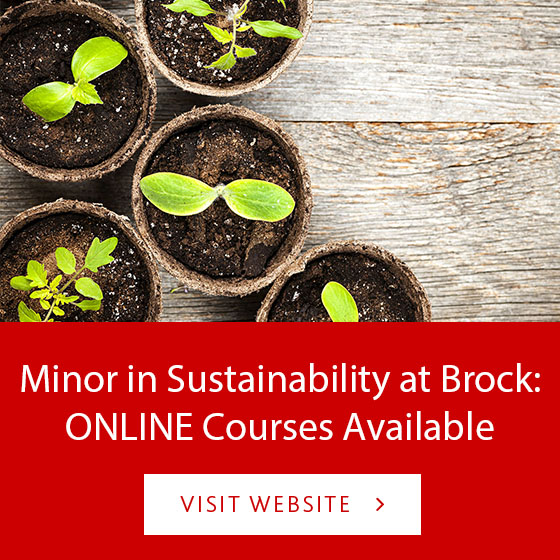Published on April 23 2014
Article from the Brock News
Brock has increased its University-wide waste diversion rate by five per cent.
According to its annual waste audit for 2013, Brock generated 1.94-million kilograms of solid non-hazardous waste.
Of this total, the University diverted 65.3 per cent of this waste – or more than 1.26-million kilograms – from ending up in landfills. Brock’s waste diversion rate, based on the 2012 audit, was 60.3 per cent.
“This is a great improvement from last year,” says Domenic Maniccia, director of Custodial Services. “If everyone pitches in we should see this rate even higher next year.”
Of the total amount of annual waste diverted at Brock, 327,000 kgs was composted, 898,000 kgs was recycled, 40,000 kgs was reused, and 500 kgs was reduced.
The latest audit also highlights areas for improvement.
The highest contributors to the University’s 1.94-million kgs waste stream are organic wastes (26 per cent), followed by mixed containers (cans, plastic and cartons) at 9 per cent and coffee cups at 4.6 per cent.
“Can we do more as a community?” asks Maniccia. “Absolutely. We have containers available throughout our campuses to easily capture these recyclable materials.”
– See more at: https://brocku.ca/brock-news/?p=27671&utm_source=feedburner&utm_medium=email&utm_campaign=Feed%3A+TheBrockNews+%28The+Brock+News%29#sthash.Szi7QgOZ.dpuf
Brock has increased its University-wide waste diversion rate by five per cent.
According to its annual waste audit for 2013, Brock generated 1.94-million kilograms of solid non-hazardous waste.
Of this total, the University diverted 65.3 per cent of this waste – or more than 1.26-million kilograms – from ending up in landfills. Brock’s waste diversion rate, based on the 2012 audit, was 60.3 per cent.
“This is a great improvement from last year,” says Domenic Maniccia, director of Custodial Services. “If everyone pitches in we should see this rate even higher next year.”
Of the total amount of annual waste diverted at Brock, 327,000 kgs was composted, 898,000 kgs was recycled, 40,000 kgs was reused, and 500 kgs was reduced.
The latest audit also highlights areas for improvement.
The highest contributors to the University’s 1.94-million kgs waste stream are organic wastes (26 per cent), followed by mixed containers (cans, plastic and cartons) at 9 per cent and coffee cups at 4.6 per cent.
“Can we do more as a community?” asks Maniccia. “Absolutely. We have containers available throughout our campuses to easily capture these recyclable materials.”
– See more at: https://brocku.ca/brock-news/?p=27671&utm_source=feedburner&utm_medium=email&utm_campaign=Feed%3A+TheBrockNews+%28The+Brock+News%29#sthash.Szi7QgOZ.dpuf
Brock has increased its University-wide waste diversion rate by five per cent.
According to its annual waste audit for 2013, Brock generated 1.94-million kilograms of solid non-hazardous waste.
Of this total, the University diverted 65.3 per cent of this waste – or more than 1.26-million kilograms – from ending up in landfills. Brock’s waste diversion rate, based on the 2012 audit, was 60.3 per cent.
“This is a great improvement from last year,” says Domenic Maniccia, director of Custodial Services. “If everyone pitches in we should see this rate even higher next year.”
Of the total amount of annual waste diverted at Brock, 327,000 kgs was composted, 898,000 kgs was recycled, 40,000 kgs was reused, and 500 kgs was reduced.
The latest audit also highlights areas for improvement.
The highest contributors to the University’s 1.94-million kgs waste stream are organic wastes (26 per cent), followed by mixed containers (cans, plastic and cartons) at 9 per cent and coffee cups at 4.6 per cent.
“Can we do more as a community?” asks Maniccia. “Absolutely. We have containers available throughout our campuses to easily capture these recyclable materials.”
Brock has increased its University-wide waste diversion rate by five per cent.
According to its annual waste audit for 2013, Brock generated 1.94-million kilograms of solid non-hazardous waste.
Of this total, the University diverted 65.3 per cent of this waste – or more than 1.26-million kilograms – from ending up in landfills. Brock’s waste diversion rate, based on the 2012 audit, was 60.3 per cent.
“This is a great improvement from last year,” says Domenic Maniccia, director of Custodial Services. “If everyone pitches in we should see this rate even higher next year.”
Of the total amount of annual waste diverted at Brock, 327,000 kgs was composted, 898,000 kgs was recycled, 40,000 kgs was reused, and 500 kgs was reduced.
The latest audit also highlights areas for improvement.
The highest contributors to the University’s 1.94-million kgs waste stream are organic wastes (26 per cent), followed by mixed containers (cans, plastic and cartons) at 9 per cent and coffee cups at 4.6 per cent.
“Can we do more as a community?” asks Maniccia. “Absolutely. We have containers available throughout our campuses to easily capture these recyclable materials.”
– See more at: https://brocku.ca/brock-news/?p=27671&utm_source=feedburner&utm_medium=email&utm_campaign=Feed%3A+TheBrockNews+%28The+Brock+News%29#sthash.Szi7QgOZ.dpuf
According to its annual waste audit for 2013, Brock generated 1.94-million kilograms of solid non-hazardous waste.
Of this total, the University diverted 65.3 per cent of this waste – or more than 1.26-million kilograms – from ending up in landfills. Brock’s waste diversion rate, based on the 2012 audit, was 60.3 per cent.
“This is a great improvement from last year,” says Domenic Maniccia, director of Custodial Services. “If everyone pitches in we should see this rate even higher next year.”
Of the total amount of annual waste diverted at Brock, 327,000 kgs was composted, 898,000 kgs was recycled, 40,000 kgs was reused, and 500 kgs was reduced.
The latest audit also highlights areas for improvement.
The highest contributors to the University’s 1.94-million kgs waste stream are organic wastes (26 per cent), followed by mixed containers (cans, plastic and cartons) at 9 per cent and coffee cups at 4.6 per cent.
“Can we do more as a community?” asks Maniccia. “Absolutely. We have containers available throughout our campuses to easily capture these recyclable materials.”
… to continue reading this article, visit the Brock News.
